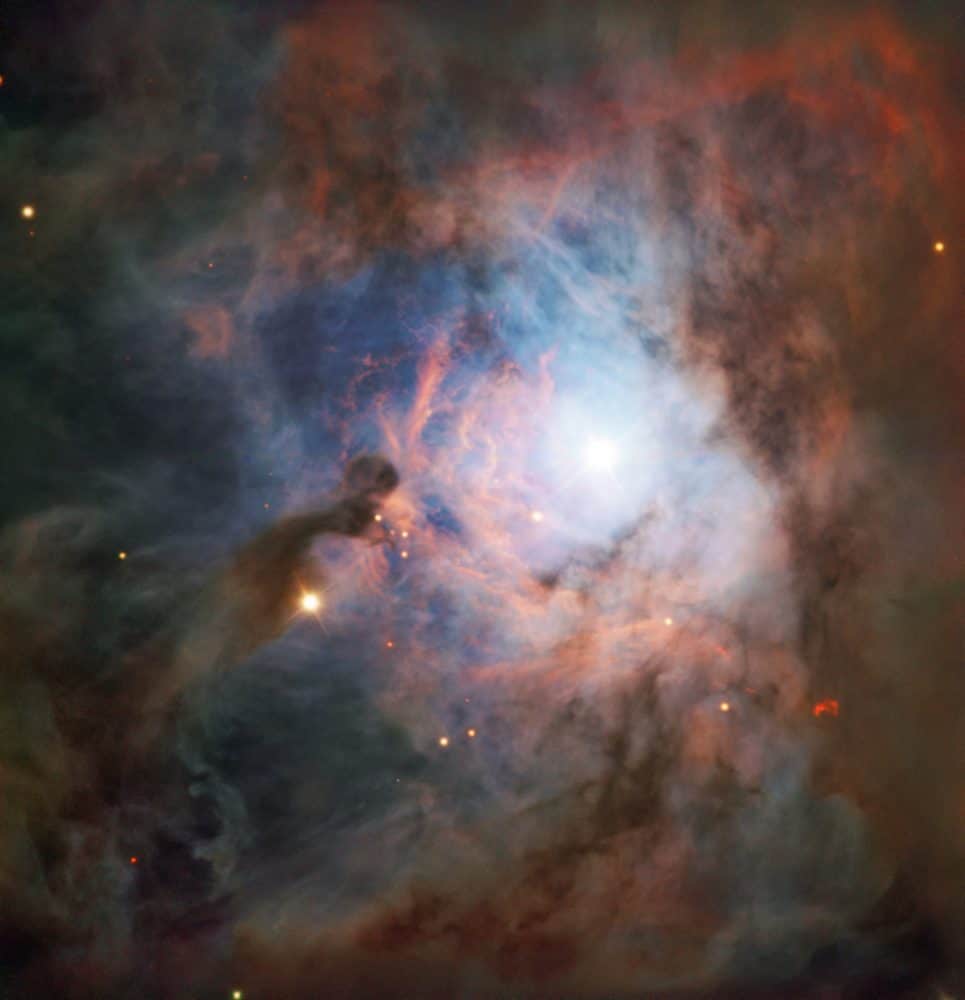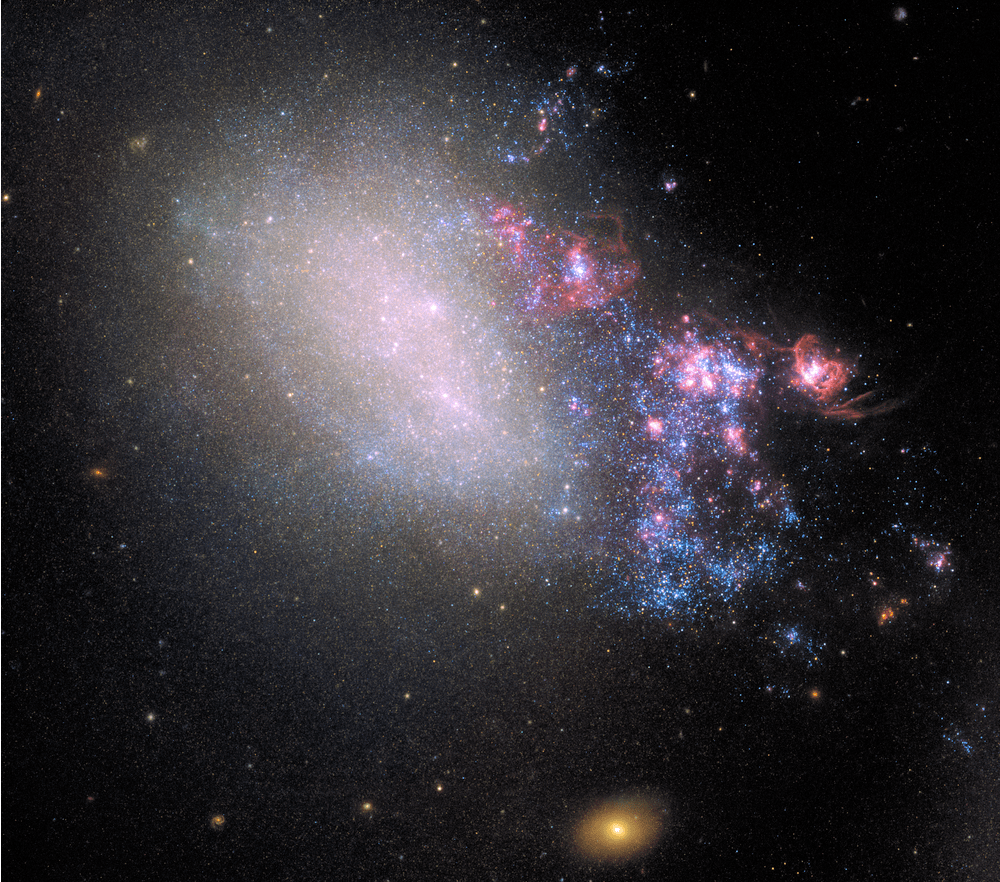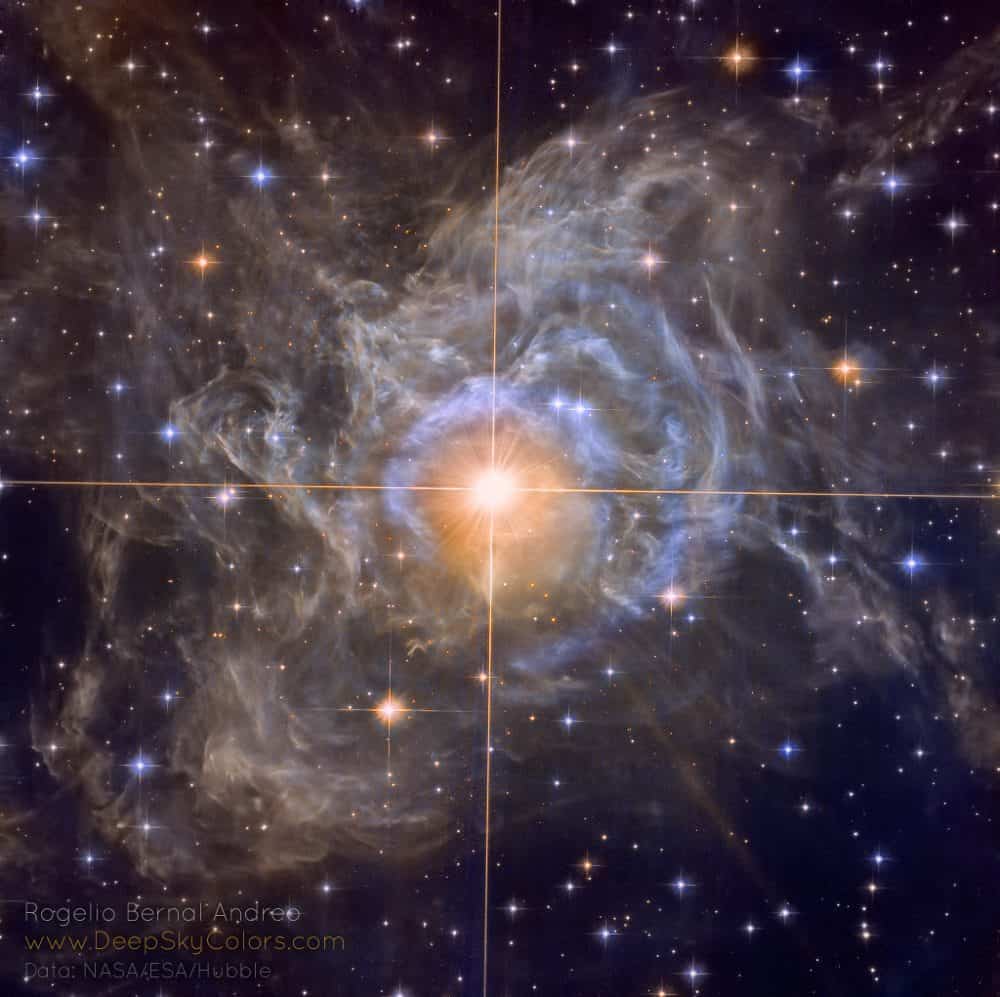Blog
Reflection nebulae are clouds of interstellar dust that reflect the light from nearby or internal sources, like fog around a car headlight.
NGC 2023 is one of the largest reflection nebulae in the sky.
Also known as LBN 954 or IRAS 05391-0217, the nebula was discovered by the British astronomer William Herschel on January 6, 1785.
The object is about 1,500 light-years away from Earth, very close to the well-known Horsehead and Flame nebulae.
NGC 2023 is illuminated by a massive young star named HD 37903.
The star is extremely hot — several times hotter than the Sun — and its bright blue-white light causes NGC 2023’s milky glow.
Such nebulae are often the birthplaces of stars, and contain a clumpy distribution of gas that’s significantly denser than the surrounding medium.
Under the influence of gravity, these clumps attract one another and merge, eventually creating a new star.
This new image of NGC 2023 was taken with VLT’s FOcal Reducer and Spectrograph (FORS) instrument as part of the ESO Cosmic Gems program.
This initiative produces images of interesting and visually attractive objects using ESO telescopes, for the purposes of education and outreach.
more...John Robert Cocker OBE (20 May 1944 – 22 December 2014), better known as Joe Cocker, was an English singer. He was known for his gritty voice, spasmodic body movement in performance, and distinctive versions of popular songs of varying genres. Cocker’s recording of the Beatles‘ “With a Little Help from My Friends” reached number one in the UK in 1968. He performed the song live at Woodstock in 1969 and performed the same year at the Isle of Wight Festival, and at the Party at the Palace concert in 2002 for the Golden Jubilee of Queen Elizabeth II. His version also became the theme song for the TV series The Wonder Years. His 1974 cover of “You Are So Beautiful” reached number five in the US. Cocker was the recipient of several awards, including a 1983 Grammy Award for his US number one “Up Where We Belong“, a duet with Jennifer Warnes.
In 1993, Cocker was nominated for the Brit Award for Best British Male, in 2007 was awarded a bronze Sheffield Legends plaque in his hometown and in 2008 he received an OBE at Buckingham Palace for services to music. Cocker was ranked number 97 on Rolling Stone‘s 100 greatest singers list.
more...Charles Davis (May 20, 1933 – July 15, 2016) was an American jazz saxophonist and composer. Davis played alto, tenor and baritone saxophone, and performed extensively with Archie Shepp and Sun Ra. Born in Goodman, Mississippi, Davis was raised in Chicago. He graduated from DuSable High School before studying at the Chicago School of Music. Davis also studied privately with John Hauser. During the 1950s, he played with Billie Holiday, Ben Webster, Sun Ra and Dinah Washington. Davis also performed and recorded with Kenny Dorham, with whom he associated musically for many years.
During the 1960s, he performed and recorded with Elvin Jones, Jimmy Garrison, Illinois Jacquet, Freddie Hubbard, Johnny Griffin, Steve Lacy and Ahmad Jamal, also working with Blue Mitchell, Erskine Hawkins, John Coltrane and Clifford Jordan. In 1964, Davis topped Downbeat Magazine‘s International Jazz Critics Poll for baritone saxophone. He performed in the musical The Philosophy of The Spiritual – A Masque of the Black with Willie Jones, produced by Nadi Qamar. Davis taught at PS 179 in Brooklyn and was musical director of the Turntable, a nightclub owned by Lloyd Price.
During the 1970s, Davis was a member of the cooperative Artistry in Music with Hank Mobley, Cedar Walton, Sam Jones and Billy Higgins. He co-led, composed and arranged for the Baritone Saxophone Retinue, a six-baritone-saxophone group. Davis toured Europe, playing major jazz festivals and concerts with the Clark Terry Orchestra, and toured the United States with Duke Ellington’s Orchestra under the direction of Mercer Ellington. As musical director of the Home of the Id nightclub, he presented Gene Ammons, Randy Weston and Max Roach. As producer of the Monday Night Boat Ride Up The Hudson, Davis presented Art Blakey, George Benson and Etta Jones. He appeared on television with Archie Shepp, Lucky Thompson, Ossie Davis and Ruby Dee.
more...Edward Louis Smith (May 20, 1931 – August 20, 2016) was an American jazz trumpeter from Memphis, Tennessee.
After graduating from Tennessee State University he attended graduate school at the University of Michigan. While studying at the University of Michigan, he played with visiting musicians such as Dizzy Gillespie, Miles Davis, Thad Jones and Billy Mitchell,[1] before going on to play with Sonny Stitt, Count Basie and Al McKibbon, Cannonball Adderley, Percy Heath, Philly Joe Jones, Lou Donaldson, Donald Byrd, Kenny Dorham and Zoot Sims.[1] Smith decided to forego being a full-time musician to take a job a director of Atlanta’s Booker T. Washington High School. There he recorded two albums for Blue Note.
The first, Here Comes Louis Smith, originally recorded for the Boston-based Transition Records, featured Cannonball Adderley (then under contract to Mercury) playing under the pseudonym “Buckshot La Funke”, Tommy Flanagan, Duke Jordan, Art Taylor and Doug Watkins. He also replaced Donald Byrd for Horace Silver’s Live at the Newport 1958 set. His playing on the set was one of his best efforts and was described by one critic as “monstrous”. He was a prolific composer and successful band director leaving Booker T. Washington to become director of the Jazz Ensemble at the University of Michigan and a teacher in Ann Arbor’s public school system. He later recorded for the SteepleChase label.
Smith suffered a stroke in 2006, and was seen occasionally enjoying live jazz in the Detroit/Ann Arbor area, but did not return to performing.
His cousin Booker Little was also a trumpeter.
Smith died on August 20, 2016, at age 85.
more...This composite image shows the distribution of dark matter, galaxies, and hot gas in the core of the merging galaxy cluster Abell 520, formed from a violent collision of massive galaxy clusters.
The natural-colour image of the galaxies was taken with the NASA/ESA Hubble Space Telescope and with the Canada-France-Hawaii Telescope in Hawaii. Superimposed on the image are maps showing the concentration of starlight, hot gas, and dark matter. Starlight from galaxies, derived from observations by the Canada-France-Hawaii Telescope, is coloured orange. The green-tinted regions show hot gas, as detected by NASA’s Chandra X-ray Observatory. The gas is evidence that a collision took place. The blue-coloured areas pinpoint the location of most of the mass in the cluster, which is dominated by dark matter. Dark matter is an invisible substance that makes up most of the Universe’s mass. The dark-matter map was derived from the Hubble Wide Field Planetary Camera 2 observations by detecting how light from distant objects is distorted by the cluster of galaxies, an effect called gravitational lensing.
The blend of blue and green in the centre of the image reveals that a clump of dark matter resides near most of the hot gas, where very few galaxies are found. This finding confirms previous observations of a dark-matter core in the cluster. The result could present a challenge to basic theories of dark matter, which predict that galaxies should be anchored to dark matter, even during the shock of a collision.
Abell 520 resides 2.4 billion light-years away.
more...Peter Dennis Blandford Townshend (born 19 May 1945) is an English multi-instrumentalist, singer and songwriter best known as the guitarist, backing and secondary lead vocalist, principal songwriter, co-founder and leader of the rock band the Who. His career with the Who spans over 50 years, during which time the band grew to be one of the most important and influential rock bands of the 20th century.
Pete Townshend is the main songwriter for the Who, having written well over 100 songs for the band’s 11 studio albums, including concept albums and the rock operas Tommy and Quadrophenia, plus popular rock radio staples such as Who’s Next, and dozens more that appeared as non-album singles, bonus tracks on reissues, and tracks on rarities compilations such as Odds & Sods (1974). He has also written more than 100 songs that have appeared on his solo albums, as well as radio jingles and television theme songs. Although known primarily as a guitarist, he also plays keyboards, banjo, accordion, harmonica, ukulele, mandolin, violin, synthesiser, bass guitar, and drums, on his own solo albums, several Who albums and as a guest contributor to an array of other artists’ recordings. He is self-taught on all of the instruments he plays and has never had any formal training.
Townshend has also contributed to and authored many newspaper and magazine articles, book reviews, essays, books, and scripts, and he has collaborated as a lyricist and composer for many other musical acts. Due to his aggressive playing style and innovative songwriting techniques, Townshend’s works with the Who and in other projects have earned him critical acclaim. He was ranked No. 3 in Dave Marsh‘s list of Best Guitarists in The New Book of Rock Lists, No. 10 in Gibson.com’s list of the top 50 guitarists,[5] and No. 10 again in Rolling Stone‘s updated 2011 list of the 100 greatest guitarists of all time. In 1983, Townshend received the Brit Award for Lifetime Achievement; in 1990, he was inducted into the Rock and Roll Hall of Fame as a member of the Who; in 2001, he received a Grammy Lifetime Achievement Award as a member of the Who; and in 2008 he received Kennedy Center Honors. He and Roger Daltrey received The George and Ira Gershwin Award for Lifetime Musical Achievement at UCLA on 21 May 2016.
https://www.youtube.com/watch?v=LQM2NeKdK4o
more...Cecil McBee (born May 19, 1935) is an American jazz bassist, one of the most influential in the history of jazz. McBee has recorded as a leader only a handful of times since the 1970s, but has contributed as a sideman to a number of jazz albums. McBee was born in Tulsa, Oklahoma, on May 19, 1935. He studied clarinet at school, but switched to bass at the age of 17, and began playing in local nightclubs. After gaining a music degree from Ohio Central State University, he spent two years in the army, during which time he conducted the band at Fort Knox. In 1959 he played with Dinah Washington, and in 1962 he moved to Detroit, where he worked with Paul Winter‘s folk-rock ensemble in 1963–64. His jazz career began to take off in the mid-1960s, after he moved to New York, when he began playing and recording with a number of significant musicians including Miles Davis, Andrew Hill, Sam Rivers, Jackie McLean (1964), Wayne Shorter (1965–66), Charles Lloyd (1966), Yusef Lateef(1967–69), Keith Jarrett, Freddie Hubbard and Woody Shaw (1986), and Alice Coltrane (1969–72).
Cornelius “Sonny” Fortune (May 19, 1939 – October 25, 2018) was an American jazz saxophonist. Fortune played soprano, alto, tenor, and baritone saxophones, clarinet, and flute.
After moving to New York City in 1967, Fortune recorded and appeared live with drummer Elvin Jones‘s group. In 1968 he was a member of Mongo Santamaría‘s band. He performed with singer Leon Thomas, and with pianist McCoy Tyner (1971–73). In 1974 Fortune replaced Dave Liebman in Miles Davis‘s ensemble, remaining until spring 1975, when he was succeeded by Sam Morrison. Fortune can be heard on the albums Big Fun, Get Up With It, Agharta, and Pangaea, the last two recorded live in Japan. Fortune joined Nat Adderley after his brief tenure with Davis, then formed his own group in June 1975, recording two albums for the Horizon Records. During the 1990s, he recorded several albums for Blue Note. He has also performed with Roy Brooks, Buddy Rich, George Benson, Rabih Abou Khalil, Roy Ayers, Oliver Nelson, Gary Bartz, Rashied Ali, and Pharoah Sanders, as well as appearing on the live album The Atlantic Family Live at Montreux (1977).
https://www.youtube.com/watch?v=FzCTmdsISRE
more...The irregular galaxy NGC 4485 shows all the signs of having been involved in a hit-and-run accident with a bypassing galaxy. Rather than destroying the galaxy, the chance encounter is spawning a new generation of stars, and presumably planets.
The right side of the galaxy is ablaze with star formation, shown in the plethora of young blue stars and star-incubating pinkish nebulas. The left side, however, looks intact. It contains hints of the galaxy’s previous spiral structure, which, at one time, was undergoing normal galactic evolution.
The larger culprit galaxy, NGC 4490, is off the bottom of the frame. The two galaxies sideswiped each other millions of years ago and are now 24,000 light-years apart. The gravitational tug-of-war between them created rippling patches of higher-density gas and dust within both galaxies. This activity triggered a flurry of star formation.
This galaxy is a nearby example of the kind of cosmic bumper-car activity that was more common billions of years ago when the universe was smaller and galaxies were closer together.
NGC 4485 lies 25 million light-years away in the northern constellation Canes Venatici (the Hunting Dogs).
more...Lou Bennett (May 18, 1926, Philadelphia – February 10, 1997, Paris) was an American jazz organist.
Bennett first played bebop on piano, but started playing organ in 1956 after hearing Jimmy Smith. Bennett toured the U.S. with an organ trio between 1957 and 1959, and then moved to Paris in 1960. There he recorded and performed at the Blue Note with Jimmy Gourley and Kenny Clarke (as well as Rene Thomas); he returned to America only once, for the 1964 Newport Jazz Festival. He also recorded in the 1960s with Philip Catherine, Shirley Bunnie Foy and Franco Manzecchi. In the 1980s he played in his own quintet with Gerard Badini, among others. During this period he also toured extensively throughout Spain, including, Almeria, Barcelona, La Coruna, Segovia, and Madrid.
more...Kai Chresten Winding (/ˈkaɪ
After the war, Winding was a member of Benny Goodman‘s orchestra, then Stan Kenton‘s. He participated in Birth of the Cool sessions in 1949, appearing on four of the twelve tracks, while J. J. Johnson appeared on the other eight, having participated on the other two sessions.
more...
Pulsating RS Puppis, the brightest star in the image center, is some ten times more massive than our Sun and on average 15,000 times more luminous. In fact, RS Pup is a Cepheid variable star, a class of stars whose brightness is used to estimate distances to nearby galaxies as one of the first steps in establishing the cosmic distance scale. As RS Pup pulsates over a period of about 40 days, its regular changes in brightness are also seen along its surrounding nebula delayed in time, effectively a light echo. Using measurements of the time delay and angular size of the nebula, the known speed of light allows astronomers to geometrically determine the distance to RS Pup to be 6,500 light-years, with a remarkably small error of plus or minus 90 light-years. An impressive achievement for stellar astronomy, the echo-measured distance also more accurately establishes the true brightness of RS Pup, and by extension other Cepheid stars, improving the knowledge of distances to galaxies beyond the Milky Way.
more...More Posts
- Aaron Neville
- Joe Albany
- Jimmy Forrest
- World Music with Vedan Kolod
- Daily Roots with Howie Atkins
- Surviving the Pandemic and Realizing Racial Justice
- The Cosmos with Cassiopeia A
- Gary Burton
- Curtice Counce
- Django Reinhardt
- World Music with the Warsaw Village Band
- Daily Roots with Jackie Paris
- Club Calabash 33
- Surviving the Pandemic and Realizing Racial Justice
- The Cosmos with the Milky Way Ring
- Eberhard Weber
- Sam Cooke
- J. J. Johnson
- Blind Willie Johnson
- Flamenco Fridays with Antonio Campos




